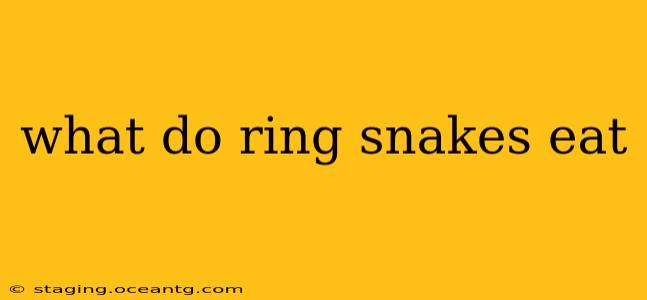Ring-necked snakes ( Diadophis punctatus) are small, secretive colubrid snakes found throughout much of North America. While their charming appearance often captures attention, understanding their dietary habits is key to appreciating their ecological role. This guide delves into the fascinating world of what these captivating creatures consume, addressing common questions about their diet.
What is the main food source for ring-necked snakes?
The primary food source for ring-necked snakes is earthworms. These legless amphibians are readily available, nutritious, and relatively easy to catch for these slender snakes. Ring-necked snakes are adept at locating earthworms both on the surface and by probing beneath leaf litter and soil. Their diet isn't exclusively earthworms, however, as they are opportunistic feeders.
What other types of prey do ring-necked snakes consume?
While earthworms dominate their diet, ring-necked snakes are opportunistic predators and will consume a variety of other small invertebrates, including:
- Slugs and Snails: These soft-bodied mollusks provide a readily available source of moisture and nutrients.
- Insects: Ring-necked snakes may occasionally prey on insects such as beetles, grasshoppers, and caterpillars. However, this is less frequent compared to their earthworm consumption.
- Salamanders and Caecilians: In some instances, particularly larger ring-necked snakes, small salamanders or caecilians may be included in their diet.
- Other invertebrates: This may include spiders, centipedes, and other small creatures they encounter.
How do ring-necked snakes hunt their prey?
Ring-necked snakes are ambush predators, relying on patience and stealth to capture their food. They often remain hidden beneath rocks, logs, or leaf litter, waiting for unsuspecting prey to come within striking distance. Once prey is detected, they swiftly strike, using their sharp teeth to subdue and swallow their meal whole. Their jaws are quite flexible, allowing them to consume prey larger than their head.
What size prey do ring-necked snakes eat?
The size of prey consumed by a ring-necked snake is directly related to the size of the snake itself. Younger, smaller snakes will prey on correspondingly smaller invertebrates, while larger adults can handle larger earthworms and other prey items. Generally, they target invertebrates that are proportionally sized to their own body length.
Are ring-necked snakes venomous?
No, ring-necked snakes are not venomous. They are entirely harmless to humans, despite their often-intimidating appearance. Their mild temperament and small size make them unlikely to bite, even when handled (though handling wild animals is generally discouraged).
Do ring-necked snakes eat other snakes?
Ring-necked snakes are not known to prey on other snakes. Their diet is primarily composed of invertebrates, and they lack the size and predatory adaptations to effectively hunt other reptiles.
What is the role of ring-necked snakes in their ecosystem?
Ring-necked snakes play an important role in their ecosystems as effective invertebrate controllers. By consuming earthworms, slugs, snails, and other invertebrates, they help regulate populations and maintain a balance within their habitat.
This comprehensive guide provides a detailed understanding of the ring-necked snake's diet. Their reliance on earthworms and other readily available invertebrates makes them adaptable and successful members of their respective ecosystems. Remember, observing these fascinating creatures in their natural habitat is the best way to learn more about their behavior and ecological roles.
